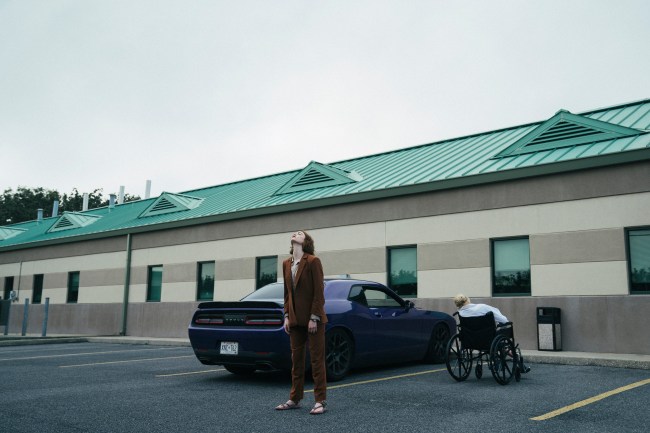In “Kinds of Kindness” by director Yorgos Lanthimos, we find, as fans of the director would expect, scenarios that go beyond rational explanations. For example, in “The Death of RMF,” the first story in the “Kindness” triptych, the viewer does not know how or why a seemingly benevolent boss (Willem Dafoe) has so much power over Robert (Jesse Plemons), who submits willingly to his employer’s bizarre demands to make love to his wife (Hong Chau) at specific times of the day, to secretly poison her drink so that she never gets pregnant (he is made to believe that she is sterile) and to agree to hit another vehicle with her car at the risk of serious injury. There’s a touch of the surreal, and even a pinch of the supernatural in two of the stories that follow, but more than anything, Lanthimos is able to immerse the viewer in the middle of these darkly comic scenarios in such a way that they are taken in by surprise. of the letter.
On the Toolkit podcast, Lanthimos was asked how he and co-writer Efthimis Filippou manage to pull this off without the normal first-act set-up and exposition of the features the collaborators have previously written together (“The Lobster,” “The Killing of a Sacred Deer,” “Dogtooth”), and so the viewer isn’t left looking for a backstory to explain the exaggerated control/submission dynamics in each film’s three short stories.
“It requires more attention (in terms of screenwriting), but it requires more letting go,” Lanthimos said. “If you let go and just accept things as they come, I think it becomes easier to get into it, then you start engaging with your own ideas of what it is and where it’s going, and I find that much more fulfilling.”
The director also asks his actors to draw on their own instinctive reactions to fill in the blanks. As actor Jesse Plemons, who made his Lanthimos debut alongside Emma Stone and Dafoe, discovered in “Kindness,” the director is not one to answer actors’ questions about the characters’ motivations and backstories.
“It’s hard because I don’t have much to offer (actors) if that’s their main need,” Lanthimos said. “The motivation, the context and all that stuff, I didn’t even think about it when I wrote the script. The information I think I can give them is already in the script.”
This goes against Hollywood concepts of screenwriting, in which gurus demand that writers do the work necessary to flesh out the rules of your narrative universe (no matter how fantastical) and the events that lead up to it, so that even without providing exposition, the world and characters feel fleshed out to the audience. But Lanthimos and Filippou aren’t exactly lazy, they worked on the script for five years, the project evolved enormously through its multiple iterations, until the demanding director felt it was ready to be filmed. They omit this aspect because their interests and focus lie elsewhere.

At every level of the filmmaking process, including screenwriting, Lanthimos does his best to separate his narrative universe from a specific place, story, time period from the real world – anything that gives gives the viewer a context to connect to the human behavior their camera observes. Take for example the setting of the film, New Orleans. The cinematography is naturalistic, the locations real, and yet, in the hands of Lanthimos and his team of longtime collaborators, one of the world’s most singular cities is stripped (framed) of its distinct culture and ambiance , becoming a substitute for a generic American town/village with the warm climate, lake, and other miscellaneous details that Lanthimos needed for this story.
“We’re not going to try to make this happen necessarily in this particular (city),” Lanthimos said. “I don’t mind people recognizing it, it’s just that we never intended to make it clear where it is.”
By sealing off its narrative world, by preventing the viewer from making connections with the outside world, we are forced to observe both the horror and the black comedy of human behavior in the film and bring our instinctive reactions to it. what we are looking at. It’s also what Lanthimos needs from his talented actors, and over the years he has developed a theater camp-like rehearsal process to achieve the physical, instinctive, and daring performances that are so distinct and essential to his films.
Rehearsals are exercises, often “silly theater games,” that do not actually involve rehearsing scenes. For example, Lanthimos will ask the actors to play musical chairs while learning their lines. Or he will give an actor a specific action, for example: “Get up and have a cup of water every time you speak.” When speaking about the exercises, Lanthimos described his intention behind them.
“The actor is more focused on the action itself, at the same time, they’re trying to learn and remember their lines, so they’re not sitting there in a very rational way, thinking, ‘Oh, how do I say this? What does this mean? Do I need another layer. That’s basically how we talk in life, we don’t really think about it,” Lanthimos said. “When the text gets into them in that way, they’re freer to try things out during the day, to be present and react to the other actor, instead of thinking too much about their character.”
The lightness and laughter that comes from the exercises are also important to Lanthimos. On the one hand, his personal reaction to horror is to find the humor first, and he needs the actors to see that too, but more importantly, he wants the camaraderie that comes from the exercises.
“It allows them to be generous to each other, to trust each other more, to know that they can do anything and that the other person won’t pass judgment because you’ve been through all of that and you’ve does all the stupid things in front of the other person,” Lanthimos said. “I think it’s very important that they feel that way, it frees up a lot of their creativity and makes them bolder in their choices.”

It’s the environment that allows something like Stone to break into his unscripted dance at the end of the film, and is featured in the trailer for “Kindness.” Lanthimos said his leadership is most encouraging when he sees bold choices he likes. Adding: “But it’s very instinctive. I don’t say, ‘Oh, that’s not good because 10 years ago, I thought this character did that.’ It’s more about… just the tone and how it correlates with the rest of the story, or with the characters, or just with the general perception and taste of things.
“Kindness” had a bumper opening in five theaters in New York and Los Angeles on June 21, and will expand to additional cities today before hitting about 1,000 screens in July.

